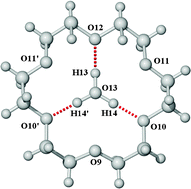Crown ethers as stabilising ligands for oxonium ions†
Abstract
Oxonium ions (H+·(H2O)n) can be stabilised and isolated in the solid state by using

- This article is part of the themed collection: In honour of Jerry Atwood
a
School of Chemistry, Monash University, Clayton, Australia
E-mail:
peter.junk@sci.monash.edu.au
Fax: 61-3-9905 4597
Tel: 61-3-9905 4570
Oxonium ions (H+·(H2O)n) can be stabilised and isolated in the solid state by using

 Please wait while we load your content...
Something went wrong. Try again?
Please wait while we load your content...
Something went wrong. Try again?
P. C. Junk, New J. Chem., 2008, 32, 762 DOI: 10.1039/B800122G
To request permission to reproduce material from this article, please go to the Copyright Clearance Center request page.
If you are an author contributing to an RSC publication, you do not need to request permission provided correct acknowledgement is given.
If you are the author of this article, you do not need to request permission to reproduce figures and diagrams provided correct acknowledgement is given. If you want to reproduce the whole article in a third-party publication (excluding your thesis/dissertation for which permission is not required) please go to the Copyright Clearance Center request page.
Read more about how to correctly acknowledge RSC content.
 Fetching data from CrossRef.
Fetching data from CrossRef.
This may take some time to load.
Loading related content
